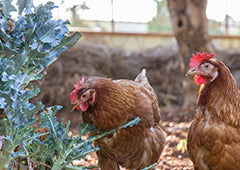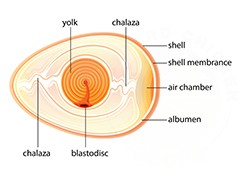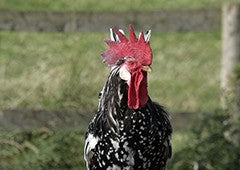It’s a very common practice among backyard chicken keepers to keep LOTS of egg-exquisitely different breeds! Why? Chicken keeping is quite addictive and once bitten by the chicken keeping bug; you’ll find yourself continually quoting the old adage, “The more the merrier!” Every year when spring has sprung up all around you, you get that urge, yes, you know the one. You get the urge to add a chick, chick here and a chick chick there, and before you know it, you’ve got oodles of lovely breeds clucking about in your backyard. And, what is the absolute best thing about having a multi-colored multi-breed flock? Yes, you guessed it…LOTS of egg-straordinarily different colored eggs! Yay!

Egg-cellent Background on Egg Color
Did you know that all eggs are white, in the beginning? It makes no difference which breed of chicken laid the egg. Also, several factors come into play which can determine or affect the color of a hen’s egg. A hen’s overall health can affect the color of her eggshell, for egg-sample, eggshells will be a paler shade if she is struggling with parasites or illness. Basking in the sun for long time periods or being without access to fresh cool water can also cause a hen’s eggs to be much lighter, even white-ish if she is a tinted egg layer.
Here’s a Trivia Tidbit you can use to quiz your family and friends. A hen’s earlobe color may be a clue as to the color of egg that she will lay. Hens with white earlobes typically lay white eggs, while hens with red earlobes usually lay tinted or brown, blue, green and pink eggs!
1. Bright White and In the Spotlight!
White eggs are simply eggs sans pigment added from the hen’s reproductive system. Even without a tint or darker “paint”, white eggs are striking like the bold full moon’s glow on a dark night and have a beauty all their own.
White Egg Layers
Leghorns, Silkies, Hamburgs, Sebrights, Polish, Lakenvelders, Minorcas, Andalusians
2. Bravo, Beautiful Brown Eggs!
Do your egg baskets hold some beautiful brown eggs? Though brown egg layers are very common in many backyard flocks, their eggs are nothing short of egg-straordinary! To get any one of the myriad shades of brown eggshells, a pigment known as protoporphyrin, from a hen’s hemoglobin, is painted on during the last few hours of the egg laying process. These masterpieces in varying shades of light browns through the spectrum to a rich chocolate brown color are determined by more than a dozen of a hen’s genes. That being said, if you dabble in a little backyard breeding, crossing a light brown egg layer with a darker brown egg layer should, for all intents and purposes, yield a hen that lays a medium brown egg. However, to add a touch of mystery to this already intricate process, some hens possess a gene which actually represses or completely prevents the brown pigment from being painted on. Wow!
Seasons come and seasons go, but did you know that brown egg color is lighter in the warmer months and darker in the colder months? And, as a hen ages, her eggs will contain less pigment and lean toward the lighter end of the brown spectrum.
Cream or Light Tan Egg Layers
Wyandottes, Faverolles, Dorkings, Buff Orpingtons, Some Easter Eggers
Brown Egg Layers
Rhode Island Reds, New Hampshire Reds, Dominiques, Delawares, Cochins, Brahmas, Plymouth Rocks, Chanteclers
Dark Brown or Chocolate Colored Egg Layers
Black Copper Marans, Cuckoo Marans, Blue Copper Marans, Barnevelders
3. Blue Chicken Eggs, Green Eggs, and Pink Eggs, Oh My!
Just as you adore gazing up at a beautiful cloudless summer sky of blue, you will be egg-ceptionally giddy when you behold your first colorful egg! Alongside the Easter Egger, there are a few special breeds that'll produce colorful eggs to brighten up your day.
Blue Chicken Egg Layers
Ameraucanas, Araucanas, Cream Legbars
You will marvel at the stunning blue hues of these breeds' eggs. From a pastel blue to a bright unmissable color, you'll notice these stunning shells a mile away! The color also seeps all the way through to the inside of the shell. So when you think all the excitement is with the exterior- you'd be mistaken! Both inside and out, these blue chicken eggs are truly majestic! The blue pigment responsible for these beauties is known as oocyanin and comes from the hen’s bile. It's a retrovirus that is present in the breeds genome which alters part of the egg laying genes!
Green Egg Layers
Olive Eggers, Some Easter Eggers
I’m sure you all remember the lovable character, Sam-I-Am, in Dr. Seuss’s silly tale, Green Eggs and Ham. Poor Sam-I-Am desperately tries to convince another character of the tastiness of Green Eggs.
Well, hopefully you will need no convincing and will thrill at adding a green egg layer to your backyard flock. Anyway, to get the green egg color, the hen’s artistic reproductive system begins with a blue egg and paints a touch of brown on top yielding a very enjoyable green egg! The darker the brown top coat, the darker the green egg!
Pink-ish Egg Layers
Light Sussex, Some Easter Eggers, Some Australorps, Plymouth Rocks
Pink is such a lovely bubblegum hue, but when you think pink, do you think about chicken eggs? Well, you should because though only a handful of chooks lay these subtle hued eggs, it is in fact an eggshell color! Pink eggs are the result of the bloom or cuticle being painted on just prior to the egg being laid. If thicker layers of bloom are applied you’ll get a darker pink or plum colored egg.
4. Eggs that Make a Speck-tacle of Themselves!
Bedazzling speckled eggs are a rare and special treat! And, while the dynamic duo of chickens responsible for laying these eggs on a regular basis are the Cuckoo Marans and the Welsummers , other breeds do at times lay these egg-straordinary specimens. Speckled eggshells occur when the egg rotates during the pigmenting stage. Apparently these eggs rotate too slowly and voila…speckles!
Speckled Egg Layers
Cuckoo Marans, Welsummers
Fancy some blue chicken eggs on your kitchen counter? Maybe one green ones too? Think about adding one, a couple, or even several of these chicken breeds to your backyard flock and spruce up your coop with colour! Here’s to waking up to a rainbow of colour in your egg gathering basket! Cheers!
As well as choosing hens with colourful eggs, there are so many other aspects you may want to consider, such as egg production rate, friendliness, and hardiness. Deciding to become a chicken parent is the easy part. The hardest is deciding which breed is most suitable for you. It can be eggtremely confusing and difficult – so where should you begin?
Cluckily, the eggsperts over at Chickenpedia have created an amazing Chicken Breeds Course. This extensive online course shares useful advice on choosing the right chickens for you as well as size, colour & frequency of eggs laid. You’ll even learn about their individual personalities, and be able to use their family-friendly compatibility scale through this well-structured program. It really is a great way to find your perfect backyard buddies which is why I highly recommend them to all of my readers! The courses are beginner-friendly and filled with vital information to help you raise a happy, healthy flock.
As chicken keepers, we want to do an eggcellent job when caring for our feathered friends, but many of us struggle to handle chicken health or behavior issues, especially in the first few years of having a flock. Chickenpedia have a full range of comprehensive online courses that cover everything you didn’t know you need to know and then some more! From healthcare to raising baby chicks to feeding and behavior, that’ll give you the knowledge and confidence to successfully look after your chickens.
As a member, you will get access to ALL their fantastic courses. So, no need to wing it, become a confident chicken keeper. Click here to check out Chickenpedia today!


















